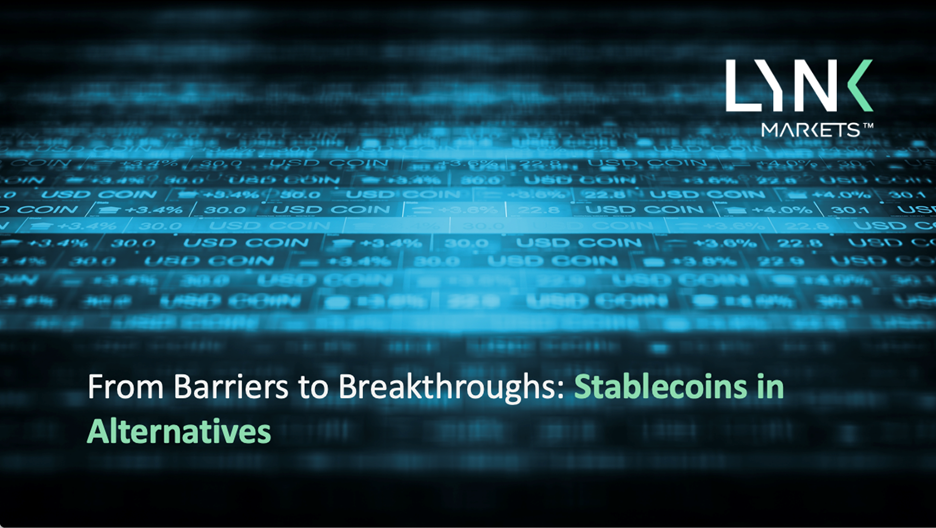Stablecoins and the New Era of Alternatives: Opportunities and Trade-Offs for Managers
Stablecoins and the New Era of Alternatives
Stablecoins and the New Era of Alternatives: Opportunities and Trade-Offs for Managers

The quiet revolution beneath alternatives
Stablecoins—digital tokens pegged to fiat currencies like the U.S. dollar or euro—are no longer a curiosity confined to crypto traders. Over the past two years, they’ve become an increasingly credible financial instrument, sitting at the intersection of payments, tokenized funds, and investor access.
For the $13 trillion global alternatives industry, the rise of stablecoins is reshaping how capital moves, how investors enter private markets, and how liquidity is managed. Asset managers and wealth managers alike now face a new question: do stablecoins represent the rails that can carry alternatives into their next growth phase—or just another operational risk in shiny packaging?
Why alternatives are paying attention
Unlike traditional equities or bonds, alternative investments—private equity, private credit, real estate, infrastructure—are illiquid, complex, and typically slow to onboard new investors. Subscription cycles often stretch from days to weeks, hampered by manual wire transfers, banking cut-offs, and compliance checks.
Stablecoins promise to change that. By serving as a programmable, always-on settlement asset, they can compress those timelines from T+3 to near-instant. When paired with tokenized fund structures, they allow alternative managers to reduce minimum investment thresholds and open the door to a wider pool of qualified investors.
Hamilton Lane’s $5.6 billion secondaries fund, for instance, tokenized a feeder vehicle and cut its minimum to $20,000—a fraction of the traditional $5 million entry ticket. Subscriptions were denominated in stablecoins, lowering costs and expanding distribution. Similar experiments from Franklin Templeton and BlackRock in money-market tokenization have already demonstrated the power of USDC (a dollar-backed stablecoin) as a settlement rail.
For Asset Managers – Pros and Cons
Upside: Faster fundraising, wider distribution
- Capital calls in minutes, not days. Stablecoin rails can speed up LP commitments, letting GPs deploy capital more efficiently.
- Global reach. Managers can attract international capital without being bound by local banking hours or FX friction.
- Reduced ticket sizes. Tokenized feeders funded via stablecoins expand the investor base to wealth platforms and family offices.
Challenges: Operational and reputational risk
- Issuer dependency. A stablecoin is only as strong as its issuer’s reserves and governance. Runs and “depegs” are not theoretical—they’ve happened.
- Regulatory patchwork. MiCA in the EU provides a path forward, but U.S. and UK frameworks remain in flux, complicating compliance.
- Brand sensitivity. Managers with fiduciary reputations to protect may hesitate to hold “crypto money” on balance sheets, even if regulated.
In short, stablecoins can accelerate fundraising and distribution, but they require robust operational playbooks, dual-rail contingency plans, and strong disclosures to investors.
For Wealth Managers – Pros and Cons
Upside: Liquidity, access, client experience
- 24/7 subscriptions and redemptions. Clients can move in and out of tokenized funds even on weekends, aligning more closely with digital-first expectations.
- Diversification at lower thresholds. Stablecoins make it practical to allocate into alternatives with much smaller tickets, broadening portfolio construction options.
- Cross-border efficiency. Wealth managers serving global HNWIs and family offices can cut remittance costs and settlement delays.
Challenges: Suitability and compliance risk
- KYC/AML complexity. Wealth managers must ensure wallets are whitelisted, addresses screened, and Travel Rule data exchanged.
- Client education. Stablecoins still feel like “crypto” to many investors; explaining issuer risk, redemption rights, and regulatory protections is non-negotiable.
- Operational readiness. Custody, reporting, and tax systems are not yet universally adapted to handle on-chain cash legs.
For wealth managers, the appeal is client experience and broader diversification—but the burden lies in risk education, due diligence on issuers, and integrating compliance solutions.
The strategic trade-off
Stablecoins are not a silver bullet. They are claims on an issuer, not deposits at a bank. They add counterparty and operational risk that must be weighed against the undeniable gains in speed, access, and flexibility.
The question for both asset and wealth managers is not “if stablecoins matter,” but “which stablecoins, under which regulatory regime, and with what operational guardrails?”
Looking ahead
Over the next three years, expect to see:
- MiCA-compliant stablecoins (like Circle’s EURC) dominate European distribution flows.
- Tokenized feeder funds proliferating across private equity, private credit, and real estate, lowering barriers for smaller qualified investors.
- Institutional liquidity pools in tokenized money-market funds, linked directly to stablecoin rails, providing alternatives managers with intraday treasury tools.
The real innovation is not the token itself—it’s the programmability of money. When the “cash leg” of private markets becomes software, the entire lifecycle of alternative investments—from subscription to distribution—can be re-engineered for scale.
Final word
For asset managers, stablecoins are a growth lever—if operational and reputational risks are contained. For wealth managers, they’re an access tool—if compliance and client education are handled with rigor.
Together, they mark the start of an era where alternatives are not just for institutions and the ultra-wealthy but are increasingly available, accessible, and liquid—one stablecoin at a time.
Disclaimer: The content of this blog post is for informational purposes only and is not intended as investment advice, as an offer or solicitation of an offer to buy or sell, or as a recommendation, endorsement, or sponsorship of any security, company, or fund. The information provided does not constitute investment advice, financial advice, trading advice, or any other sort of advice and you should not treat any of the content as such. LYNK Markets does not recommend that any securities should be bought, sold, or held by you. Do your own due diligence and consult your financial advisor before making any investment decisions.
